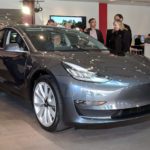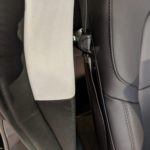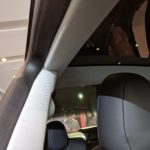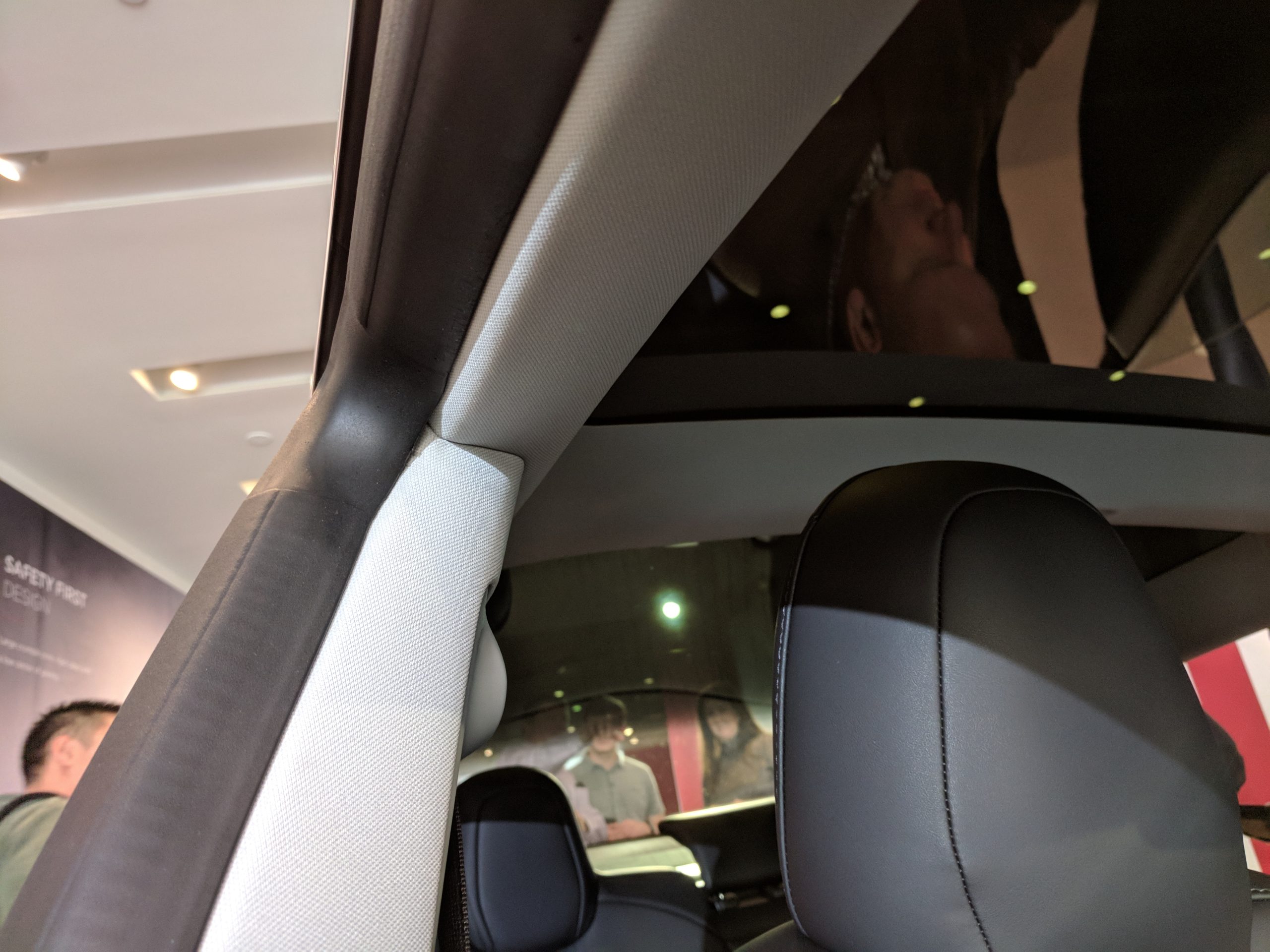
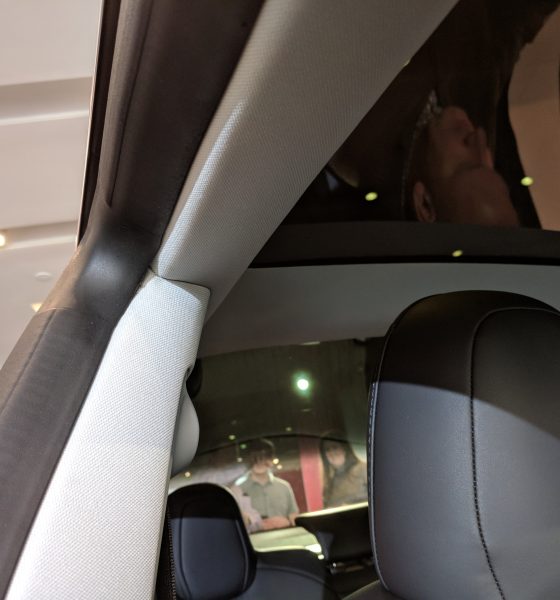
News
Tesla updates Model 3 with same premium textile material as Model S, X
Tesla Model 3 buyers first noted a material change for the vehicle’s interior trim from an Alcantara-like material to textile fabric. Though Tesla has never officially marketed the type of material used in Model 3’s interior, many would-be buyers, especially those who opted-in for the car’s Premium Upgrades package – a required upgrade for first production cars – too notice.
One of the things that truly stood out with the Model 3 was its minimalistic, elegant interior. In both the press kit of the vehicle on Tesla’s official website and the Model 3’s online configurator, images of the car with Premium Upgrades feature pillars that are fitted with what appears to be a suede-like fabric. Photos were taken of an early production Model 3, as featured in our DIY article on how to install a Model 3 dashcam, show an interior that’s covered in the premium Alcantara material.
While Tesla never specified the type of material it would use for the vehicle’s headliner and pillars; many Model 3 reservation holders were under the impression that Alcantara will be fitted in their car’s interior.
For a while, this seemed to be the case. First deliveries of the Model 3 featured a suede-like fabric on the interior of the mass market compact electric sedan. Earlier today, however, observations emerged in the forum community that newer batches of the Model 3 featured a different material for the car’s interior. Instead of having Alcantara in the vehicle’s headliner and pillars, the new batches of the electric vehicles were spotted with textile fabric.
- Tesla Model 3 at the Palo Alto, CA store [Credit: Alex Guberman at E for Electric]
- Tesla Model 3 with textile interior fabric at the Palo Alto, CA store [Credit: Alex Guberman at E for Electric]
- Tesla Model 3 with textile interior fabric at the Palo Alto, CA store [Credit: Alex Guberman at E for Electric]
Tesla Model 3 with textile interior fabric at the Palo Alto, CA store [Credit: Alex Guberman at E for Electric]
A Tesla spokesperson confirmed with Teslarati that Model 3 will be produced with the same premium textile material that’s used in Model S and Model X vehicles.
“As we continue to increase production of Model 3 and produce more high quality cars for customers, all Model 3 vehicles are being made with the same premium textile headliner found in our flagship Model S and Model X vehicles, which has always been planned at this stage of production.”
It’s worth noting that changes in material with regards to the electric vehicles’ interior have also been done in the past, both on the Model S and Model X.
Tesla has been known to discontinue items, in its efforts to continuously upgrade and refine both the materials used in its fleet of vehicles, as well as the process by which these materials are applied to its fleet of electric vehicles. Being able to iterate quickly, in all regards, is what has allowed the Silicon Valley-based electric car maker to be able to scale as quickly as they have, while drastically improving upon the quality and feature sets of its vehicles over time.
Tesla streamlined its production process last year when the company consolidated the number of interior trim options made available on the Model X, after bundling popular configurations together. The same configurations later trickled down to Model S, along with a reduced set of battery offerings made available for both flagship cars. In that regard, the unification of headliner material from Alcantara to premium textile in Model 3, S and X makes a lot of sense.
Tesla owners have remarked that the textile used in the Model X, which is the same fabric used now in the Model 3, shares the same characteristics to the material used in the headliner of the Mercedes-Benz E-Class. According to some Tesla owners that have experienced the material, the textile that Tesla fitted in its flagship Model S and Model X is not only durable; it’s really easy to clean as well.

News
Tesla FSD fleet is nearing 7 billion total miles, including 2.5 billion city miles
As can be seen on Tesla’s official FSD webpage, vehicles equipped with the system have now navigated over 6.99 billion miles.

Tesla’s Full Self-Driving (Supervised) fleet is closing in on almost 7 billion total miles driven, as per data posted by the company on its official FSD webpage.
These figures hint at the massive scale of data fueling Tesla’s rapid FSD improvements, which have been quite notable as of late.
FSD mileage milestones
As can be seen on Tesla’s official FSD webpage, vehicles equipped with the system have now navigated over 6.99 billion miles. Tesla owner and avid FSD tester Whole Mars Catalog also shared a screenshot indicating that from the nearly 7 billion miles traveled by the FSD fleet, more than 2.5 billion miles were driven inside cities.
City miles are particularly valuable for complex urban scenarios like unprotected turns, pedestrian interactions, and traffic lights. This is also the difference-maker for FSD, as only complex solutions, such as Waymo’s self-driving taxis, operate similarly on inner-city streets. And even then, incidents such as the San Francisco blackouts have proven challenging for sensor-rich vehicles like Waymos.
Tesla’s data edge
Tesla has a number of advantages in the autonomous vehicle sector, one of which is the size of its fleet and the number of vehicles training FSD on real-world roads. Tesla’s nearly 7 billion FSD miles then allow the company to roll out updates that make its vehicles behave like they are being driven by experienced drivers, even if they are operating on their own.
So notable are Tesla’s improvements to FSD that NVIDIA Director of Robotics Jim Fan, after experiencing FSD v14, noted that the system is the first AI that passes what he described as a “Physical Turing Test.”
“Despite knowing exactly how robot learning works, I still find it magical watching the steering wheel turn by itself. First it feels surreal, next it becomes routine. Then, like the smartphone, taking it away actively hurts. This is how humanity gets rewired and glued to god-like technologies,” Fan wrote in a post on X.
News
Tesla starts showing how FSD will change lives in Europe
Local officials tested the system on narrow country roads and were impressed by FSD’s smooth, human-like driving, with some calling the service a game-changer for everyday life in areas that are far from urban centers.

Tesla has launched Europe’s first public shuttle service using Full Self-Driving (Supervised) in the rural Eifelkreis Bitburg-Prüm region of Germany, demonstrating how the technology can restore independence and mobility for people who struggle with limited transport options.
Local officials tested the system on narrow country roads and were impressed by FSD’s smooth, human-like driving, with some calling the service a game-changer for everyday life in areas that are far from urban centers.
Officials see real impact on rural residents
Arzfeld Mayor Johannes Kuhl and District Administrator Andreas Kruppert personally tested the Tesla shuttle service. This allowed them to see just how well FSD navigated winding lanes and rural roads confidently. Kruppert said, “Autonomous driving sounds like science fiction to many, but we simply see here that it works totally well in rural regions too.” Kuhl, for his part, also noted that FSD “feels like a very experienced driver.”
The pilot complements the area’s “Citizen Bus” program, which provides on-demand rides for elderly residents who can no longer drive themselves. Tesla Europe shared a video of a demonstration of the service, highlighting how FSD gives people their freedom back, even in places where public transport is not as prevalent.
What the Ministry for Economic Affairs and Transport says
Rhineland-Palatinate’s Minister Daniela Schmitt supported the project, praising the collaboration that made this “first of its kind in Europe” possible. As per the ministry, the rural rollout for the service shows FSD’s potential beyond major cities, and it delivers tangible benefits like grocery runs, doctor visits, and social connections for isolated residents.
“Reliable and flexible mobility is especially vital in rural areas. With the launch of a shuttle service using self-driving vehicles (FSD supervised) by Tesla in the Eifelkreis Bitburg-Prüm, an innovative pilot project is now getting underway that complements local community bus services. It is the first project of its kind in Europe.
“The result is a real gain for rural mobility: greater accessibility, more flexibility and tangible benefits for everyday life. A strong signal for innovation, cooperation and future-oriented mobility beyond urban centers,” the ministry wrote in a LinkedIn post.
News
Tesla China quietly posts Robotaxi-related job listing
Tesla China is currently seeking a Low Voltage Electrical Engineer to work on circuit board design for the company’s autonomous vehicles.

Tesla has posted a new job listing in Shanghai explicitly tied to its Robotaxi program, fueling speculation that the company is preparing to launch its dedicated autonomous ride-hailing service in China.
As noted in the listing, Tesla China is currently seeking a Low Voltage Electrical Engineer to work on circuit board design for the company’s autonomous vehicles.
Robotaxi-specific role
The listing, which was shared on social media platform X by industry watcher @tslaming, suggested that Tesla China is looking to fill the role urgently. The job listing itself specifically mentions that the person hired for the role will be working on the Low Voltage Hardware team, which would design the circuit boards that would serve as the nervous system of the Robotaxi.
Key tasks for the role, as indicated in the job listing, include collaboration with PCB layout, firmware, mechanical, program management, and validation teams, among other responsibilities. The role is based in Shanghai.
China Robotaxi launch
China represents a massive potential market for robotaxis, with its dense urban centers and supportive policies in select cities. Tesla has limited permission to roll out FSD in the country, though despite this, its vehicles have been hailed as among the best in the market when it comes to autonomous features. So far, at least, it appears that China supports Tesla’s FSD and Robotaxi rollout.
This was hinted at in November, when Tesla brought the Cybercab to the 8th China International Import Expo (CIIE) in Shanghai, marking the first time that the autonomous two-seater was brought to the Asia-Pacific region. The vehicle, despite not having a release date in China, received a significant amount of interest among the event’s attendees.
